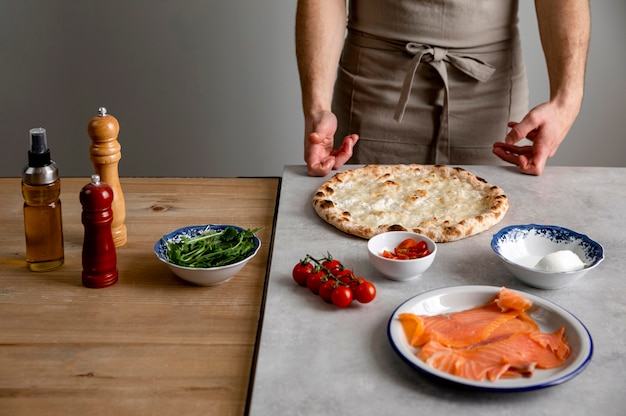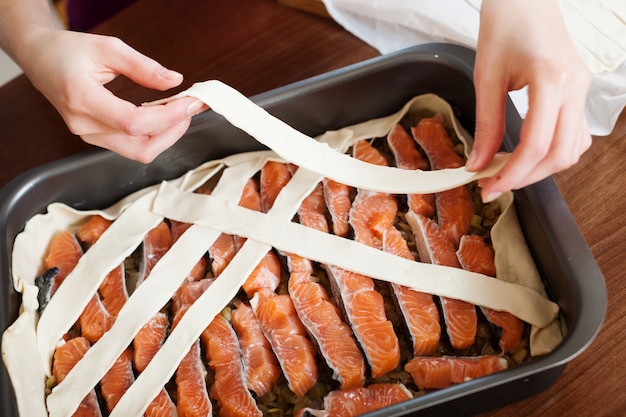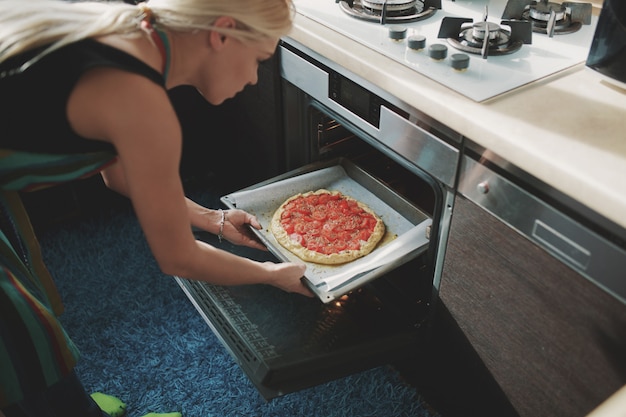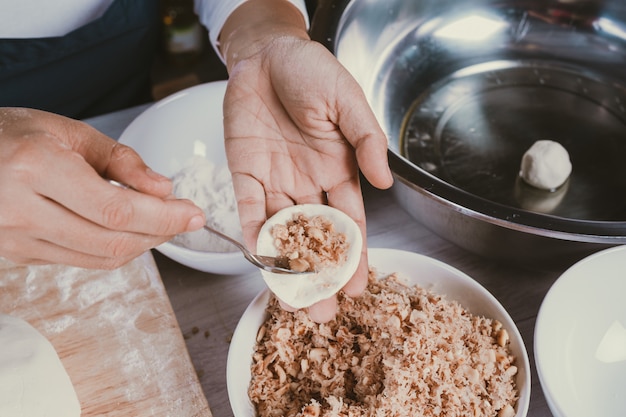As a senior article editor, I've spent countless hours poring over cookbooks and recipes, trying to find the perfect way to cook salmon. It's a fish that's always held a special place in my heart, but it can be tricky to get right. You want that delicate, flaky texture, the juicy interior, and that wonderful, almost buttery flavor. But it’s easy to overcook and end up with a dry, disappointing meal. So, I’ve dedicated myself to mastering the art of salmon, especially the oven baking method. Over time, I’ve learned a few tricks, discovered the best practices, and stumbled upon some pitfalls along the way. And I'm excited to share what I've learned with you. Let’s dive into the world of oven-baked salmon, and I’ll share all the tips and tricks I’ve gathered to ensure your salmon is always cooked to perfection.
(Part 1) Getting Started: choosing the right salmon

I truly believe that the foundation of a great salmon dish is selecting the perfect fish. It's like picking the freshest fruit – you want it to be ripe and brimming with flavor. It’s an essential first step that will make a world of difference in the final outcome.
The Fishmonger’s Guide
When I’m at the fishmonger, I use a few simple checks to ensure I’m choosing the freshest, best quality salmon. It's a little ritual that I've developed over the years, and it's always served me well. Here’s what I look for:
Skin and Flesh:
The skin should be gleaming and iridescent, almost like a shimmering pearl. It should catch the light and reflect a rainbow of colors. Avoid any dull or discolored areas. The flesh should be firm and springy to the touch, almost like a bouncy ball. It shouldn't feel soft or mushy. The color is important too. Look for a salmon that has a bright, deep red color, almost like a ruby red. If the flesh appears pale or dull, it might not be the freshest.
Smell:
Fresh salmon should have a subtle, ocean-like scent. It’s a clean, refreshing aroma that’s reminiscent of the sea. If it smells fishy or ammonia-like, it's a sign that the fish isn't fresh and should be avoided.
Thick vs. Thin:
For oven cooking, I generally prefer thicker salmon fillets. They have a more substantial texture and tend to hold their shape better during baking. This means they are less likely to become dry and will cook more evenly. However, thinner fillets have their place too. They cook faster, making them ideal for quick meals or when you’re short on time. Just be sure to adjust the cooking time accordingly, as they won’t take as long to cook through.
(Part 2) Preparation is Key: Prepping Your Salmon

Once you've selected the perfect salmon, it's time to prep it. This is where you can add your personal touch and really make the dish your own. It's all about getting the salmon ready to meet the heat of the oven.
Patting It Dry:
First, pat the salmon dry with paper towels. This might seem like a simple step, but it's essential. The moisture on the surface of the salmon can cause steam to build up during cooking, which can result in a soggy texture. By patting it dry, we ensure that the skin will crisp up nicely and the flesh will cook evenly.
Seasoning:
Now, let's talk flavor. I like to keep my salmon seasoning simple. Salt and pepper are always a classic combination, allowing the natural flavor of the fish to shine through. It's a timeless duo that rarely disappoints. But don't be afraid to get creative! A squeeze of lemon juice, a sprinkle of herbs like dill or parsley, or a drizzle of olive oil can elevate your dish to new heights. Experiment with different combinations and see what works best for you.
Glazes and Marinades:
For a more complex flavor profile, consider using a glaze or marinade. A honey-soy glaze adds a touch of sweetness and a beautiful caramelized finish, creating a delicious contrast with the savory salmon. It’s a combination I particularly enjoy. Marinades made with garlic, ginger, and soy sauce create a savory, umami-rich flavor, adding an extra layer of depth and complexity to your salmon. Just remember to let the salmon marinate for at least 30 minutes, or even better, overnight, to allow the flavors to fully penetrate the fish.
(Part 3) Understanding Oven Temperatures

Oven temperature plays a crucial role in achieving that perfectly cooked salmon. It’s a delicate balance that can make or break your dish. I usually cook my salmon at either 350°F (175°C) or 400°F (200°C), depending on the thickness and the desired outcome. Let's break down the nuances of these two temperatures:
350°F (175°C) for Gentle Cooking:
This lower temperature is ideal for thicker salmon fillets, as it allows the fish to cook through evenly without drying out. It's a gentle approach that ensures a moist and tender texture. It's also a great option if you're looking for a more delicate flavour and texture. The salmon will cook through slowly, allowing the flavors to develop more gradually.
400°F (200°C) for a Crisp Skin:
For a crispier skin and a quicker cooking time, opt for 400°F (200°C). This higher temperature will give your salmon a nice, crispy skin, and it will cook through faster. Just be sure to keep a close eye on your salmon to prevent overcooking. Because of the faster cooking time, it's essential to check the doneness frequently to avoid a dry, overcooked salmon.
(Part 4) Cooking Time: A Guide for Different Sizes
The oven cooking time for salmon is directly related to its thickness. It’s a simple equation: the thicker the salmon, the longer it takes to cook. Here's a general guideline for different sizes, but remember, oven temperatures and personal preferences can vary. It's always a good idea to check the doneness using the methods mentioned later.
Thin Fillets (under 1 inch):
10-15 minutes at 350°F (175°C) or 8-12 minutes at 400°F (200°C).
Medium Fillets (1-1.5 inches):
15-20 minutes at 350°F (175°C) or 12-15 minutes at 400°F (200°C).
Thick Fillets (over 1.5 inches):
20-25 minutes at 350°F (175°C) or 15-20 minutes at 400°F (200°C).
(Part 5) Don't Overcook: Checking for Doneness
The golden rule of salmon cooking is to never overcook. Overcooked salmon becomes dry, tough, and loses its delicate flavor. It's a culinary tragedy we must avoid at all costs. Here are some ways to check for doneness, ensuring your salmon is cooked to perfection.
The Flake Test:
Gently press the centre of the fillet with a fork. If the fish flakes easily, it's done. The flesh should separate into delicate, flaky pieces. If it resists, it needs a little more time in the oven.
The Temperature Check:
Use an instant-read thermometer to check the internal temperature of the salmon. It should reach 145°F (63°C) for a safe and delicious result. This is a crucial safety measure, ensuring that the fish is cooked thoroughly.
The Appearance Test:
The salmon will turn opaque and have a slight "whitish" layer on top when it's cooked through. The surface of the salmon will change color, becoming less translucent and more opaque. It's a subtle visual cue that indicates the fish is ready.
(Part 6) Baking Methods: Choosing the Right Approach
There are a few different ways to bake salmon in the oven, each with its own advantages. They all lead to delicious results, but they offer different textures and experiences.
Direct Baking:
The simplest method is to place the salmon directly on a baking sheet lined with parchment paper. This allows for even cooking and makes cleanup a breeze. It’s a classic technique that’s simple and effective. The parchment paper prevents sticking and ensures that the salmon doesn’t get soggy.
Baking in Foil:
Enclosing the salmon in foil creates a moist environment, which helps to prevent the fish from drying out. This is a great option if you're cooking a thinner fillet or if you want to add other ingredients like vegetables. The steam created within the foil helps to keep the salmon moist and tender. This method is perfect for creating a flavorful package with vegetables and herbs.
Baking in a Dish:
Baking in a shallow dish, like a baking pan or casserole dish, allows you to create a more elaborate presentation. You can add a sauce or a bed of vegetables to accompany your salmon. It’s a great way to add a touch of elegance to your dish, making it perfect for a special occasion.
(Part 7) Elevating Your Dish: Add-Ons and Sides
Now that you've mastered the basics, it's time to get creative with your salmon dish. Here are a few ideas to elevate your meal and transform it from ordinary to extraordinary:
Vegetables:
Roast asparagus, broccoli, or Brussels sprouts alongside your salmon. The vegetables will absorb some of the delicious flavour from the fish, creating a delightful medley of flavors.
Herbs:
Sprinkle fresh herbs like dill, parsley, or chives over your salmon before or after baking. They add a burst of freshness and enhance the overall flavour.
Citrus:
A squeeze of lemon juice or a slice of orange will brighten the flavour of your salmon and add a touch of sweetness. It creates a delicious contrast, making the salmon taste even more vibrant.
Sauces:
A simple pan sauce can really make your salmon dish sing. Deglaze the pan with wine or broth and whisk in butter, lemon juice, and herbs. It's a fantastic way to create a rich, flavorful sauce using the pan juices left from cooking the salmon.
(Part 8) Tips and Tricks
Here are a few additional tips and tricks that I've learned over the years, little secrets that I've picked up from experienced cooks and years of experimenting in the kitchen:
- Preheat your oven to the desired temperature before placing the salmon inside. This will ensure even cooking. A preheated oven ensures that the salmon cooks consistently and prevents it from taking longer to reach the desired temperature.
- Use a timer to keep track of cooking time. Salmon cooks quickly, so it's important to avoid overcooking. A timer is your best friend when cooking salmon, as it allows you to keep track of the time and ensure you don't overcook the fish.
- Don't crowd the salmon on the baking sheet. This will prevent it from steaming and ensure that all sides are evenly cooked. Give the salmon some space to breathe! It's important to have enough space around each fillet to allow for proper heat circulation.
- If you're using foil, make sure to crimp the edges tightly to prevent the steam from escaping. This will create a more moist cooking environment and prevent the salmon from drying out.
- Let the salmon rest for a few minutes after baking before serving. This allows the juices to redistribute and prevents the fish from becoming dry. A little rest is essential for succulent salmon.
(Part 9) Storage and Leftovers
leftover salmon can be stored in an airtight container in the refrigerator for up to 3 days. You can enjoy it cold in salads or sandwiches, or reheat it gently in the oven or microwave. It's a versatile dish that can be enjoyed in various forms.
(Part 10) FAQs
Here are some frequently asked questions about cooking salmon in the oven, covering some common concerns and queries:
1. How do I know if my salmon is undercooked?
If the salmon is still pink in the centre and feels a bit mushy when you press on it with a fork, it's likely undercooked. It's best to cook it a bit longer to ensure it's safe to eat. Make sure it reaches the safe internal temperature of 145°F (63°C).
2. Can I bake salmon with the skin on?
Absolutely! baking salmon with the skin on helps to protect the fish from drying out and adds a nice crispy texture. Just make sure to score the skin with a sharp knife before baking to prevent it from curling up. Scoring the skin helps to create steam release points, preventing the skin from curling and ensuring it cooks evenly.
3. How can I prevent my salmon from sticking to the baking sheet?
Line your baking sheet with parchment paper or a silicone baking mat. This will prevent the salmon from sticking and make cleanup a breeze. It’s a simple solution to a common problem.
4. What other recipes can I use for oven-baked salmon?
There are endless possibilities when it comes to oven-baked salmon! Here are a few ideas to inspire your culinary adventures:
- salmon with lemon and dill – a classic combination that never fails to impress.
- Salmon with roasted vegetables – a colorful and flavorful dish that’s perfect for a weeknight meal.
- salmon en papillote – a delicate and flavorful dish where salmon is cooked in a parchment paper packet.
- Salmon with a honey-soy glaze – a sweet and savory glaze that adds a touch of elegance to your salmon.
5. Is it okay to eat raw salmon?
Raw salmon is often used in dishes like sushi and sashimi. However, it's essential to source your salmon from a reputable provider and ensure it's been properly frozen to kill any parasites. It's best to err on the side of caution and cook your salmon to 145°F (63°C) to ensure it's safe to eat.
(Part 11) Final Thoughts
Cooking salmon in the oven is a simple yet rewarding culinary experience. With a little practice and these tips, you'll be able to create perfectly flaky, juicy, and flavorful salmon every time. Enjoy!
(Part 12) Recipes
Here's a simple recipe for oven-baked salmon that you can try at home, a classic recipe that highlights the natural flavors of the fish:
Ingredients:
- 1 pound salmon fillet
- 1 tablespoon olive oil
- 1 teaspoon salt
- 1/2 teaspoon black pepper
- 1 lemon, thinly sliced
- 1/4 cup fresh dill, chopped
Instructions:
- Preheat oven to 350°F (175°C).
- Line a baking sheet with parchment paper.
- Place the salmon fillet on the prepared baking sheet.
- Drizzle the salmon with olive oil and season with salt and pepper.
- Arrange the lemon slices on top of the salmon.
- Bake for 15-20 minutes, or until the salmon is cooked through.
- Garnish with fresh dill and serve immediately.
(Part 13) Conclusion
Now you've got all the information you need to bake the perfect salmon. Go forth, experiment, and enjoy the delightful taste of this versatile fish!
Remember, cooking is a journey of discovery, and with each salmon you bake, you'll gain more experience and confidence. And who knows, you might even discover your own secret ingredient or technique that will elevate your salmon to new heights. Happy cooking!
Everyone is watching

How to Cook Frozen Lobster Tails Perfectly: A Step-by-Step Guide
RecipesLobster. Just the word conjures up images of lavish meals, special occasions, and a taste of luxury. But let's...

Pigs in a Blanket Cooking Time: How Long to Bake for Perfect Results
RecipesAh, pigs in a blanket. Just the name conjures up images of those delightful little parcels of crispy pastry en...

Pork Fillet Cooking Time: How Long to Cook It Perfectly
RecipesPork fillet, or tenderloin as it's sometimes called, is a real favourite in our house. It's so versatile, and...

The Ultimate Guide to Cooking Delicious Frankfurters
RecipesLet's face it, we all love a good frankfurter. It's a classic, simple, and always satisfying. But let's be rea...

The Ultimate Guide to Tender, Juicy Pulled Pork
RecipesRight, let's talk pulled pork. It's one of those dishes that just screams "comfort food," doesn't it? I mean...
